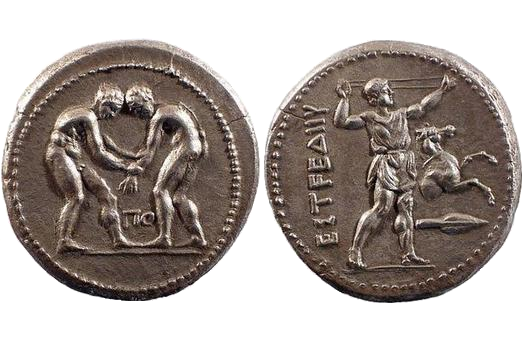
about ancient nomos
Ancient Nomos Art is a museum of galleries exhibiting ancient coins and ancient mint maps. The coin gallery displays the diverse art and history of hand-crafted ancient Greek, Roman, Byzantine, Persian and Medieval coinage. The ancient mints mapping gallery features Greek, Roman, Byzantine, Asia Minor and Medieval mint city regions and territories. Visitor's are welcome to explore, study and enjoy Ancient Nomos Art.

Greek, Aspendos – 420 BC
Pamphilia
From Ancient Galleries

Obverse: Two wrestlers grappling, man on left holding wrists, monogram between.
Reverse: Slinger standing right wearing chiton, forepart of horse above spearhead.
LEGEND SYMBOLS
Obv. Two wrestlers grappling, the one on the left holding the left wrist of the other; ΠO in lower middle field. Rev. Slinger standing right wearing a short chiton slinging to the right, forepart of horse above spearhead; to left ΕΣΤFEΔΙΙΥ, all in dotted round border.
The ancient Greek city of Aspendos was located on the Asia Minor coast between Lycia and Cilicia, in a region known as Pamphylia. The Aspendos sea port was large, wealthy and busy, exporting goods, sea-salt (Pliny, NH XXXI, 73) and grains from the nearby Anotolian plateau. The fragments of stone piers once supporting a great high-arched Roman Bridge are still visible at the ancient seaport entry, now a part of southern Turkey and the Mediterranean. The vast geographic dispersion of Aspendos minted coinage, found throughout central and southern Turkey, is evidence of economic success and of a wide silver stater circulation pattern. The British Museum notes Aspendos coinage was struck using the Persian standard, having an average weight of nearly 11 grams and equal to two sigloi. The stater obverse typically depicts two Wrestlers grappling in a tense head-to-head and arm-to-arm confrontation. Generally, two Greek letters or symbols appear between the legs and are thought to be abbreviations for the Magistrates name having mint jurisdiction during the time of engraving and striking. Numismatic scholars debate the symbolic meanings behind why Aspendos choose to depict wrestlers on their coinage. Some suggest the Wrestlers are Greek “hero” figures, perhaps even mythical figures or legends of war and battle. Others contend they are simply two dueling athletic contestants engaged in a popular Greek sport, cultural pastime, and after winning, a source of personal and regional pride. Perhaps Aspendos was the first city-state to symbolize its wrestling victories at early Olympic Games by engraving coinage. The stater reverse depicts a standing Slinger in a hurling stance to the right, wearing a short sleeveless chiton garment. The symbols to the right include the forepart of a horse along with an isolated spearhead at the fore of the slingers left shin. To the left is the Greek name believed to be associated with the founding of Aspendos, ΕΣΤFEΔΙΙΥ, perhaps referencing Asitawandas, founder of Karatepe. Many believe the Slinger may also be symbolic of an ancient heroic battle figure with mythic wartime importance. Others suggest the Slinger may symbolize another form of successful combatant or athletic contestant found in Aspendos. In addition, some scholars believe Aspendos is eponymous to the ancient Greek word for “sling” (σφενδονη), known as a “Sphendone” in ancient Greece (see also Rhodos and Selinos for other eponymous names), thus semantically associating Aspendos with a Sling.
DOCUMENTATION
Value: Stater. Metal: AR Silver. Weight: 10.44 grams. Mint: Aspendos, Pamphylia. Date: circa 420-370 BC.
Attribution: Boston MFA 2101; SNG France 3; SNG Copenhagen 245 (eagle variety).
Legend, Documentation and Attribution
